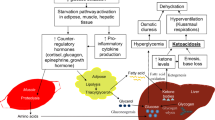Abstract
Carnitine is an essential co-factor in fatty acid metabolism. Carnitine deficiency can impair fatty acid oxidation, rarely leading to hyperammonemia and encephalopathy. We present the case of a 35-year-old woman who developed acute mental status changes, asterixis, and diffuse muscle weakness. Her ammonia level was elevated at 276 μg/dL. Traditional ammonia-reducing therapies were initiated, but proved ineffective. Pharmacologic, microbial, and autoimmune causes for the hyperammonemia were excluded. The patient was severely malnourished and her carnitine level was found to be extremely low. After carnitine supplementation, ammonia levels normalized and the patient’s mental status returned to baseline. In the setting of refractory hyperammonemia, this case illustrates how careful investigation may reveal a treatable condition.




Similar content being viewed by others
References
Koizumi A, Nozaki J, Ohura T, et al. Genetic epidemiology of the carnitine transporter OCTN2 gene in a Japanese population and phenotypic characterization in Japanese pedigrees with primary systemic carnitine deficiency. Hum Mol Genet. 1999;8:2247–54.
Pons R, Carrozzo R, Tein I, et al. Deficient muscle carnitine transport in primary carnitine deficiency. Pediatr Res. 1997;42:583–7.
Glasgow AM, Engel AG, Bier DM, et al. Hypoglycemia, hepatic dysfunction, muscle weakness, cardiomyopathy, free carnitine deficiency and long-chain acylcarnitine excess responsive to medium chain triglyceride diet. Pediatr Res. 1983;17:319–26.
Di Donato S, Pelucchetti D, Rimoldi M, et al. Systemic carnitine deficiency: clinical, biochemical, and morphological cure with L-carnitine. Neurology. 1984;34:157–62.
Wilcken B, Wiley V, Sim KG, Carpenter K. Carnitine transporter defect diagnosed by newborn screening with electrospray tandem mass spectrometry. J Pediatr. 2001;138:581–4.
Tokatli A, Coskun T, Ozalp I. Fifteen years’ experience with 212 hyperammonaemic cases at a metabolic unit. J Inherit Metab Dis. 1991;14:698–706.
Samtoy B, DeBeukelaer MM. Ammonia encephalopathy secondary to urinary tract infection with Proteus mirabilis. Pediatrics. 1980;65:294–7.
Mutchnick MG, Lerner E, Conn HO. Portal-systemic encephalopathy and portacaval anastomosis: a prospective, controlled investigation. Gastroenterology. 1974;66:1005–19.
Planas R, Gomes-Vieira MC, Cabre E, et al. Prognostic factors of hepatic encephalopathy after portacaval anastomosis: a multivariate analysis in 50 patients. Am J Gastroenterol. 1992;87:1792–6.
Seashore JH, Seashore MR, Riely C. Hyperammonemia during total parenteral nutrition in children. JPEN J Parenter Enteral Nutr. 1982;6:114–8.
Hamer HM, Knake S, Schomburg U, Rosenow F. Valproate-induced hyperammonemic encephalopathy in the presence of topiramate. Neurology. 2000;54:230–2.
Verrotti A, Greco R, Morgese G, Chiarelli F. Carnitine deficiency and hyperammonemia in children receiving valproic acid with and without other anticonvulsant drugs. Int J Clin Lab Res. 1999;29:36–40.
Lokrantz CM, Eriksson B, Rosen I, Asztely F. Hyperammonemic encephalopathy induced by a combination of valproate and pivmecillinam. Acta Neurol Scand. 2004;109:297–301.
Ohtani Y, Endo F, Matsuda I. Carnitine deficiency and hyperammonemia associated with valproic acid therapy. J Pediatr. 1982;101:782–5.
Stillman A, Gitter H, Shillington D, et al. Reye’s syndrome in the adult: case report and review of the literature. Am J Gastroenterol. 1983;78:365–8.
Glasgow AM, Eng G, Engel AG. Systemic carnitine deficiency simulating recurrent Reye syndrome. J Pediatr. 1980;96:889–91.
Duran M, de Klerk JB, Wadman SK, et al. Systemic carnitine deficiency: benefit of oral carnitine supplements vs. persisting biochemical abnormalities. Eur J Pediatr. 1984;142:224–8.
Matsubasa T, Ohtani Y, Miike T, et al. Carnitine prevents Reye-like syndrome in atypical carnitine deficiency. Pediatr Neurol. 1986;2:80–4.
Matsuda I, Ohtani Y. Carnitine status in Reye and Reye-like syndromes. Pediatr Neurol. 1986;2:90–4.
Matsuda I, Ohtani Y, Ninomiya N. Renal handling of carnitine in children with carnitine deficiency and hyperammonemia associated with valproate therapy. J Pediatr. 1986;109:131–4.
Laub MC, Paetzke-Brunner I, Jaeger G. Serum carnitine during valproic acid therapy. Epilepsia. 1986;27:559–62.
Tamai I, Ohashi R, Nezu J, et al. Molecular and functional identification of sodium ion-dependent, high affinity human carnitine transporter OCTN2. J Biol Chem. 1998;273:20378–82.
Nezu J, Tamai I, Oku A, et al. Primary systemic carnitine deficiency is caused by mutations in a gene encoding sodium ion-dependent carnitine transporter. Nat Genet. 1999;21:91–4.
Korman SH, Waterham HR, Gutman A, et al. Novel metabolic and molecular findings in hepatic carnitine palmitoyltransferase I deficiency. Mol Genet Metab. 2005;86:337–43.
Roschinger W, Muntau AC, Duran M, et al. Carnitine-acylcarnitine translocase deficiency: metabolic consequences of an impaired mitochondrial carnitine cycle. Clin Chim Acta. 2000;298:55–68.
Siciliano M, Annicchiarico BE, Lucchese F, Bombardieri G. Effects of a single, short intravenous dose of acetyl-L-carnitine on pattern-reversal visual-evoked potentials in cirrhotic patients with hepatic encephalopathy. Clin Exp Pharmacol Physiol. 2006;33:76–80.
Malaguarnera M, Pistone G, Elvira R, et al. Effects of L-carnitine in patients with hepatic encephalopathy. World J Gastroenterol. 2005;11:7197–202.
Ramsay RR, Arduini A. The carnitine acyltransferases and their role in modulating acyl-CoA pools. Arch Biochem Biophys. 1993;302:307–14.
Corvi MM, Soltys CL, Berthiaume LG. Regulation of mitochondrial carbamoyl-phosphate synthetase 1 activity by active site fatty acylation. J Biol Chem. 2001;276:45704–12.
Corkey BE, Hale DE, Glennon MC, et al. Relationship between unusual hepatic acyl coenzyme A profiles and the pathogenesis of Reye syndrome. J Clin Invest. 1988;82:782–8.
Costell M, O’Connor JE, Miguez MP, Grisolia S. Effects of L-carnitine on urea synthesis following acute ammonia intoxication in mice. Biochem Biophys Res Commun. 1984;120:726–33.
Rebouche CJ. Kinetics, pharmacokinetics, and regulation of L-carnitine and acetyl-L-carnitine metabolism. Ann N Y Acad Sci. 2004;1033:30–41.
Krajcovicova-Kudlackova M, Simoncic R, Bederova A, et al. Correlation of carnitine levels to methionine and lysine intake. Physiol Res. 2000;49:399–402.
Ingenbleek Y. The nutritional relationship linking sulfur to nitrogen in living organisms. J Nutr. 2006;136:1641S–1651S.
Stipanuk MH. Sulfur amino acid metabolism: pathways for production and removal of homocysteine and cysteine. Annu Rev Nutr. 2004;24:539–77.
Tein I. Carnitine transport: pathophysiology and metabolism of known molecular defects. J Inherit Metab Dis. 2003;147–69.
Acknowledgments
Midwest SGIM Meeting (September 2006) – oral presentation
Ohio ACP Meeting (October 2006) – poster presentation
Internal Medicine 2007 (April 2007) – oral presentation
The authors did not receive any internal or external funding for this work.
Conflict of Interest
None disclosed.
Author information
Authors and Affiliations
Corresponding author
Rights and permissions
About this article
Cite this article
Limketkai, B.N., Zucker, S.D. Hyperammonemic Encephalopathy Caused by Carnitine Deficiency. J GEN INTERN MED 23, 210–213 (2008). https://doi.org/10.1007/s11606-007-0473-0
Received:
Revised:
Accepted:
Published:
Issue Date:
DOI: https://doi.org/10.1007/s11606-007-0473-0




